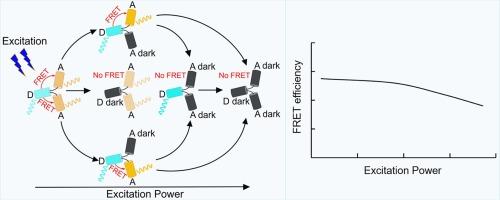双光子激发下荧光蛋白的光漂白对 FRET 测量的影响。
IF 4.3
2区 化学
Q1 SPECTROSCOPY
Spectrochimica Acta Part A: Molecular and Biomolecular Spectroscopy
Pub Date : 2024-10-17
DOI:10.1016/j.saa.2024.125294
引用次数: 0
摘要
福斯特共振能量转移(FRET)是一种广泛应用于纳米级分子距离测量的技术,这使得 FRET 成为研究蛋白质相互作用和蛋白质复合物四元结构的理想方法。在这项工作中,我们对不同激发条件下供体和受体分子的光漂白如何影响 FRET 结果很感兴趣。我们在双光子激发条件下,利用 FRET 动力学理论和给定激发条件下的数值模拟,系统地研究了激发功率和激发波长的选择对由一个供体(D)和两个受体(A)或一个受体和一个非荧光标签(N)组成的多重蛋白质构建体的 FRET 测量效率的影响。我们发现,在低激发功率和适当选择的激发波长条件下,三聚构建物 ADA 的 FRET 效率与两个二聚构建物 ADN 和 NDA 的 FRET 效率(通过无光漂白情况下的 FRET 动力学理论)之间的关系在 2% 以内。相比之下,在更高的激发功率下,由于供体(通过直接激发)和受体(主要通过 FRET 诱导激发)的光漂白,FRET 效率发生了显著变化。基于这些结果和使用简单而有效的算法进行的数值模拟,我们制定了选择适当实验条件以进行可靠 FRET 测量的指导原则,以及使用不同激发方案解释现有实验结果的指导原则。本文章由计算机程序翻译,如有差异,请以英文原文为准。

Impact of photobleaching of fluorescent proteins on FRET measurements under two-photon excitation
Förster resonance energy transfer (FRET) is a widely used technique for nanoscale molecular distance measurements, which makes FRET ideal for studying protein interactions and quaternary structure of protein complexes. In this work, we were interested in how photobleaching of donor and acceptor molecules affects the FRET results under various excitation conditions. We conducted a systematic study, under two-photon excitation, of the effects of the excitation power and the choice of excitation wavelengths upon the measured FRET efficiencies of multiplex protein constructs, consisting of one donor (D) and two acceptors (A) or one acceptor and a non-fluorescent tag (N), using both the kinetic theory of FRET and numerical simulations under given excitation conditions. We found that under low excitation power and properly chosen excitation wavelengths the relationship between the FRET efficiency of a trimeric construct ADA agrees within 2% with the FRET efficiency computed (via the kinetic theory of FRET in the absence of photobleaching) from two dimeric constructs ADN and NDA. By contrast, at higher excitation powers the FRET efficiencies changed significantly due to the photobleaching of both the donor (through direct excitation) and the acceptor (mostly through FRET-induced excitation). Based on these results and numerical simulations using a simple but competent algorithm, we developed guidelines for choosing appropriate experimental conditions for reliable FRET measurements, as well as for interpreting the results of existing experiments using different excitation schemes.
求助全文
通过发布文献求助,成功后即可免费获取论文全文。
去求助
来源期刊
CiteScore
8.40
自引率
11.40%
发文量
1364
审稿时长
40 days
期刊介绍:
Spectrochimica Acta, Part A: Molecular and Biomolecular Spectroscopy (SAA) is an interdisciplinary journal which spans from basic to applied aspects of optical spectroscopy in chemistry, medicine, biology, and materials science.
The journal publishes original scientific papers that feature high-quality spectroscopic data and analysis. From the broad range of optical spectroscopies, the emphasis is on electronic, vibrational or rotational spectra of molecules, rather than on spectroscopy based on magnetic moments.
Criteria for publication in SAA are novelty, uniqueness, and outstanding quality. Routine applications of spectroscopic techniques and computational methods are not appropriate.
Topics of particular interest of Spectrochimica Acta Part A include, but are not limited to:
Spectroscopy and dynamics of bioanalytical, biomedical, environmental, and atmospheric sciences,
Novel experimental techniques or instrumentation for molecular spectroscopy,
Novel theoretical and computational methods,
Novel applications in photochemistry and photobiology,
Novel interpretational approaches as well as advances in data analysis based on electronic or vibrational spectroscopy.

 求助内容:
求助内容: 应助结果提醒方式:
应助结果提醒方式:


